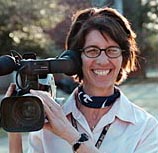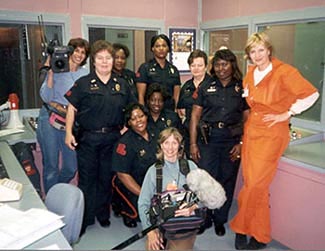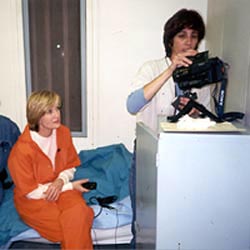When I sold my betacam a few years ago, I decided if I ever owned another broadcast camera, it would be very small and inexpensive. Maybe, there would be a market for work done in small format by producer/shooters, and I would have the qualifications. Iím in no hurry to begin this kind of enterprise. Iíve had two experiences shooting network reports on Hi-8, and they were both incredible ordeals.
The plan worked well for Dianeís portion of the shoot. She was outfitted with two cameras. One was mounted on a tripod on a cabinet in her cell. Diane recorded her thoughts a couple of times a day directly into the camera. She used the second camera to shoot freely in the cell block. This was very effective some of the time. Diane was able to talk with and tape inmates on her own, without a TV crew. I doubt she could have shot an entire piece with this rig, because the onboard microphone only got usable sound part of the time. Less distracting was the autofocus. Though it chose the prison bars sometimes, and faces other times, it was probably no less whimsical than most camera operators. For shooting the rest of the report, I insisted on bringing an audio technician. Holly Sweet, a network freelancer from Oklahoma, tried to work with the rig suggested to us by the engineering staff at ABC News. We found it inadequate, so Holly reverted to the standard package of mixer, wireless mics, and boom. It may have looked more cumbersome, but it rescued the quality of our audio.
We tried the same approach the following year, when Diane went for a visit to a cloistered convent in New Mexico. On this shoot, ABC wouldnít hire a sound technician, and we were plagued with audio problems. I felt uncomfortable with the Hi-8 camera, and struggled with the rig for the entire shoot. I didnít think there was any purpose in using the small format, since Diane was not doing any diary shooting. Flash forward to 1999. Iím spending a couple of days this month at the Platypus Workshop to check out the video training given to a group of accomplished still photographers. An opportunity to see whether small format cameras now have better lenses, better electronics, decent audio, and more professional operating controls. Iím curious to know what the emphasis is in the training: is it journalistic, or aesthetic, or technical? Iím curious to know why these photographers have the desire to learn video. I would like to know whether any of these people will demonstrate an aptitude for TV storytelling. Will audio be like the Fifth Dimension to these PlatyBees? Something that has a postulated existence, but how do you use it?? What stories do the workshop participants want to tell on television? Why would they want to undergo the tedium of shooting all the elements necessary to make a TV sequence and then write and edit it, rather than capture it all in an exposure? Why would anyone want to shoot, record, write, and edit their own footage? Almost every reporter in a tiny TV market begins under these conditions. Once they move up to a bigger station they work with a camera crew, and usually find they can do much better work. Who are the instructors, and how have their experiences been with small-format one-man-band operations? Are there opportunities for video verité? Can a field producer successfully get more stories on the air by shooting and editing them, rather than pitching them to the networks, and then waiting and waiting? Are there some stories that work much better without the betacam? I'm looking forward to finding out. Please tune in next month for my impressions
of the Platypus Workshop in Norman, Oklahoma.
 Amy Bowers
|

 The
first, was a shoot in a womenís prison in Louisiana for ABC. The small
cameras were supposed to allow us more freedom and intimacy (maybe not
the best term in a community where sexual relations are the prevailing
topic of virtually all conversation) than using more cumbersome broadcast
rigs. It would also allow the correspondent, Diane Sawyer, to record her
own video journal of her experience. Diane planned on spending two nights
in a cell in maximum security, and shooting it on a very simple consumer
camera.
The
first, was a shoot in a womenís prison in Louisiana for ABC. The small
cameras were supposed to allow us more freedom and intimacy (maybe not
the best term in a community where sexual relations are the prevailing
topic of virtually all conversation) than using more cumbersome broadcast
rigs. It would also allow the correspondent, Diane Sawyer, to record her
own video journal of her experience. Diane planned on spending two nights
in a cell in maximum security, and shooting it on a very simple consumer
camera.
 Itís
hard to know whether the small camera I used helped us establish a rapport
with the prison population. But, after a day and half with the little rig,
I decided to use the Sony D-600. I felt I could tell the same story with
the bigger camera, and produce much better video.
Itís
hard to know whether the small camera I used helped us establish a rapport
with the prison population. But, after a day and half with the little rig,
I decided to use the Sony D-600. I felt I could tell the same story with
the bigger camera, and produce much better video.